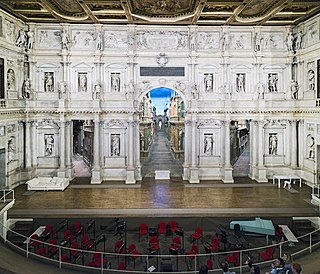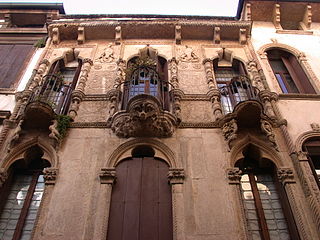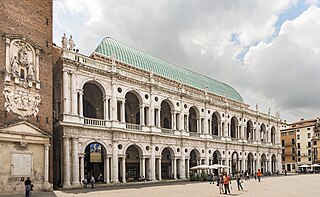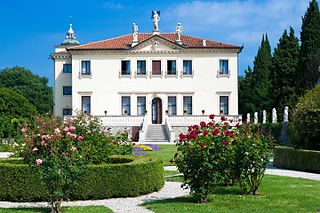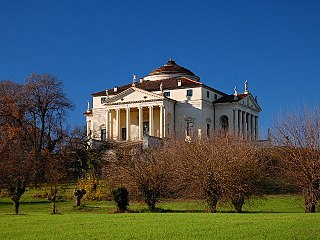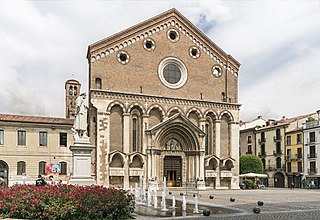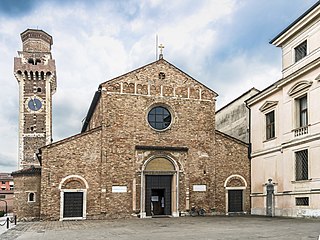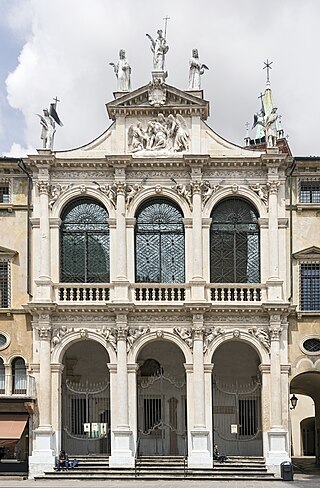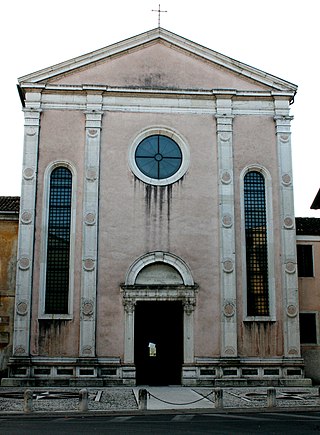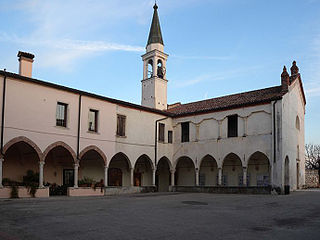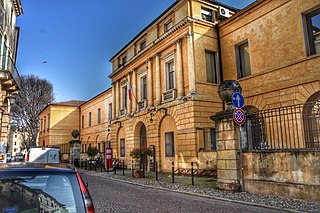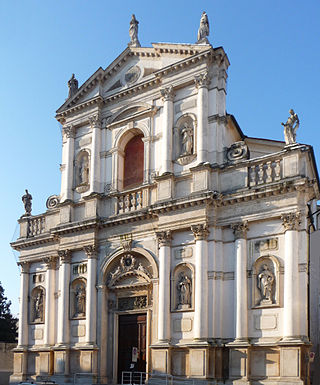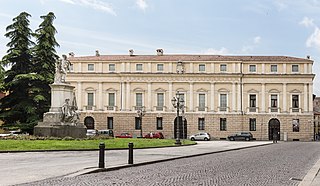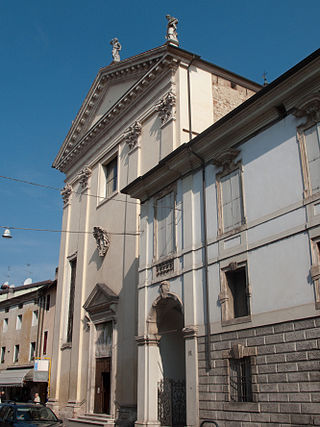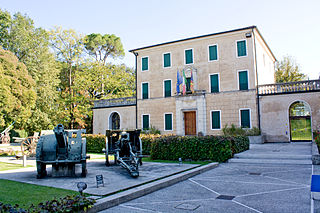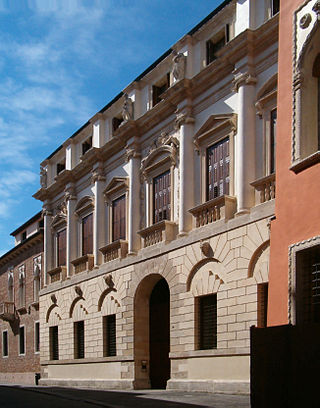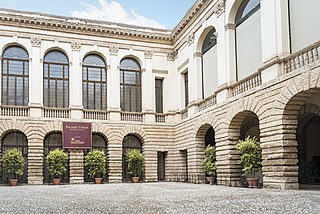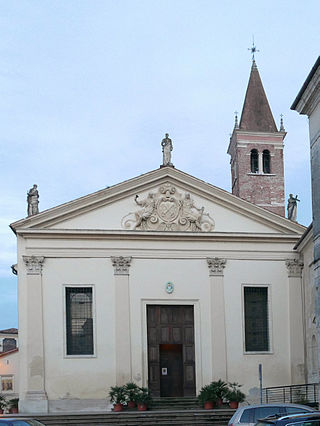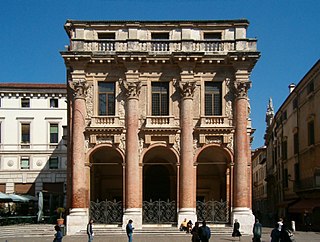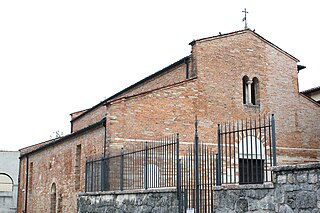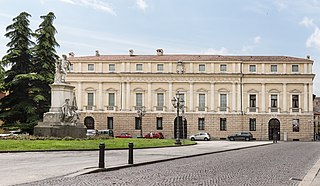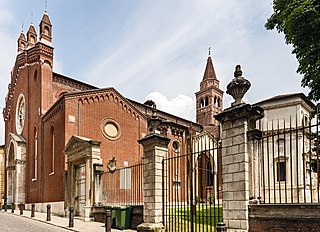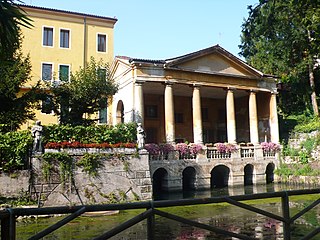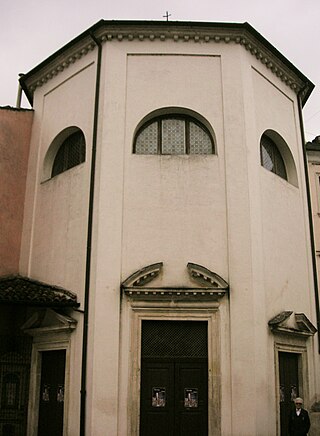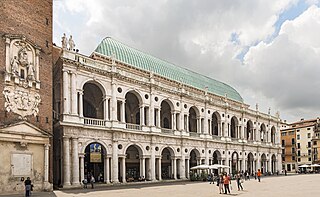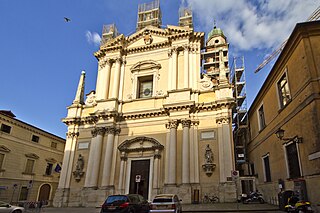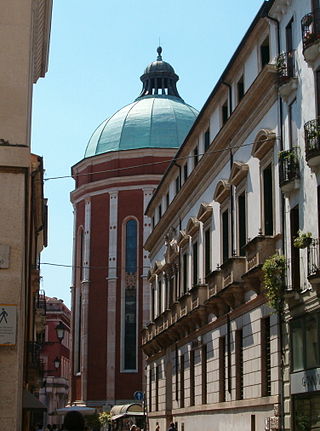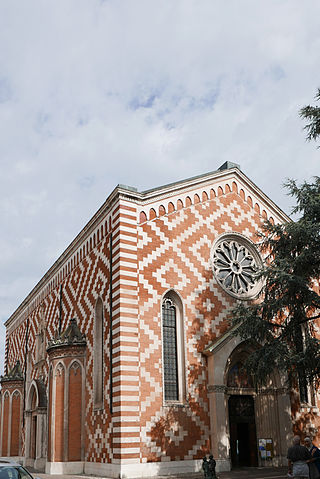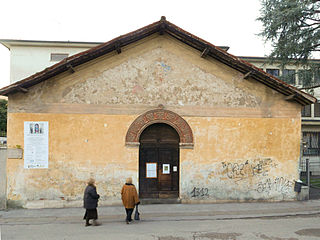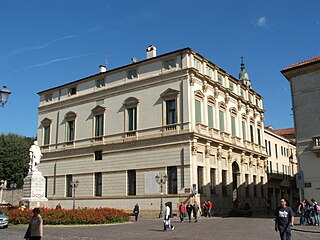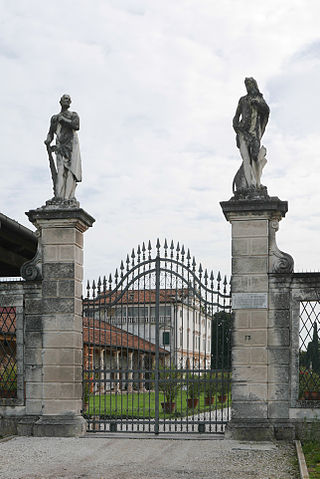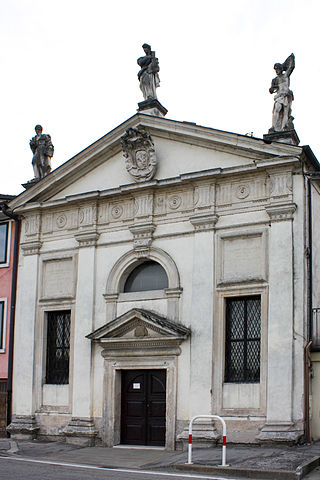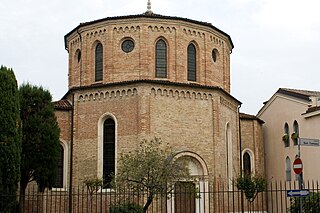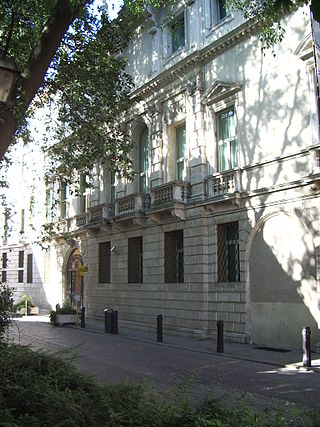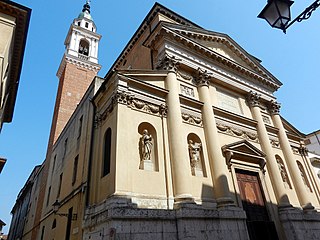42 Sights in Vicenza, Italy (with Map and Images)
Legend
Premium Sights
Book tickets, guided tours and activities in Vicenza.
Guided Free Walking Tours
Book free guided walking tours in Vicenza.
Welcome to your journey through the most beautiful sights in Vicenza, Italy! Whether you want to discover the city's historical treasures or experience its modern highlights, you'll find everything your heart desires here. Be inspired by our selection and plan your unforgettable adventure in Vicenza. Dive into the diversity of this fascinating city and discover everything it has to offer.
Sightseeing Tours in VicenzaActivities in VicenzaThe Teatro Olimpico is a theatre in Vicenza, northern Italy, constructed in 1580–1585. It was the final design by the Italian Renaissance architect Andrea Palladio and was not completed until after his death. The trompe-l'œil onstage scenery, designed by Vincenzo Scamozzi to give the appearance of long streets receding to a distant horizon, was installed in 1585 for the first performance held in the theatre, and is the oldest surviving stage set still in existence. The full Roman-style scaenae frons back screen across the stage is made from wood and stucco imitating marble. It was the home of the Accademia Olimpica, which was founded there in 1555.
Casa Pigafetta, located in Via Pigafetta in Vicenza, is a small building completed in 1481, as the classical inscription engraved above the window on the right of the ground floor meticulously recalls: MCCCCLXXXI / KL AUGUST.
The Basilica Palladiana is a Renaissance building in the central Piazza dei Signori in Vicenza, north-eastern Italy. The most notable feature of the edifice is the loggia, which shows one of the first examples of what have come to be known as the Palladian window, designed by a young Andrea Palladio, whose work in architecture was to have a significant effect on the field during the Renaissance and later periods.
Villa Valmarana ai Nani is a villa at the foot of the gates of the city of Vicenza, Veneto, Italy. The main building was completed in 1670. It is noted for its frescos by Giambattista and Giovanni Domenico Tiepolo and stone sculptures of dwarves named "Nani".
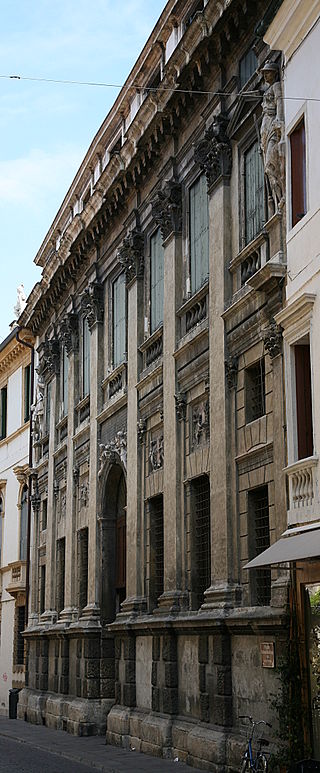
Palazzo Valmarana is a palace in Vicenza. It was built by Italian Renaissance architect Andrea Palladio in 1565 for the noblewoman Isabella Nogarola Valmarana. Since 1994 it is part of the UNESCO World Heritage Site "City of Vicenza and the Palladian Villas of the Veneto".
6. Villa Capra La Rotonda
Villa La Rotonda is a Renaissance villa just outside Vicenza in Northern Italy designed by Italian Renaissance architect Andrea Palladio, and begun in 1567, though not completed until the 1590s. The villa's official name is Villa Almerico Capra Valmarana, but it is also known as "La Rotonda", "Villa Capra", and "Villa Almerico Capra". The name Capra derives from the Capra brothers, who completed the building after it was ceded to them in 1592. Along with other works by Palladio, the building is conserved as part of the World Heritage Site "City of Vicenza and the Palladian Villas of the Veneto".
7. Chiesa di San Lorenzo
The church of San Lorenzo is a Catholic place of worship in Vicenza, built at the end of the thirteenth century in Gothic style, in its Lombard-Po Valley version of the thirteenth century. It is located in the central Piazza San Lorenzo, along Corso Fogazzaro, and was officiated by the Conventual Franciscans until 2017.
8. Chiesa Santi Felice e Fortunato
The Basilica of Saints Felice and Fortunato is a church in Vicenza, Italy, whose origin dates back to the IV-V century. its current Romanesque appearance is essentially due to the reconstruction of the twelfth century and the restorations of the twentieth century.
9. Chiesa di San Vincenzo
The church of San Vincenzo is a historic Catholic place of worship in Vicenza, whose construction with subsequent extensions goes from the end of the fourteenth to the first half of the eighteenth century. The façade overlooks Piazza dei Signori, in front of the Palladian Basilica, and is inserted in the center of the Palazzo del Monte di Pietà, interrupting its uniform texture.
10. Chiesa di San Rocco
The church of San Rocco is a Renaissance religious building in Vicenza, Italy, located in Contra' Mure San Rocco. It was built at the end of the fifteenth century, together with the adjoining convent that housed first the Canons Regular of San Giorgio in Alga, then the seventeenth century the Carmelite "teresine", then from the early nineteenth century a orphanage.
11. Chiesa di Santa Maria Maddalena
The church of Santa Maria Maddalena, also known as the Maddalene Vecchie, is a late fifteenth-century religious building located on the edge of the city of Vicenza, on the slopes of Mount Crocetta in the hamlet of Maddalene.
12. Villa Trissino
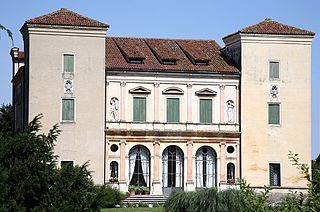
The Villa Trissino is a patrician villa, which belonged to Gian Giorgio Trissino, located at Cricoli, just outside the center of Vicenza, in northern Italy. It was mainly built in the 16th century and is associated by tradition with the architect Andrea Palladio.
13. Museo Naturalistico Archeologico
The Naturalistic Archaeological Museum of Santa Corona in Vicenza, inaugurated in 1991, is located in the premises and cloisters of the former Dominican convent adjacent to the church of Santa Corona, in the historic center.
14. Chiesa di San Marco in San Girolamo
The Church of San Marco in San Girolamo is a baroque parish church in Vicenza, northern Italy, built in the 18th century by the Discalced Carmelites. It houses various artworks by artists of the early 18th century from Veneto. The sacristy preserves its original furniture of the same period.
15. Museo diocesano
The Diocesan Museum of Vicenza preserves the most precious and significant works and documents the historical, artistic and cultural path of the Vicenza Church. The museum is set up in the Bishop's Palace, built at the end of the twelfth century and expanded over the centuries, but which owes its current appearance to the interventions of the nineteenth century and the second post-war period.
16. Chiesa di San Giuliano
The church of San Giuliano is a religious building in Vicenza, Italy. Built on previous buildings in the last years of the seventeenth century, it is located in Corso Padova, 57. Nearby - and in communication with it - is the Salvi Institute, which occupies the buildings of the convent once annexed to the church.
17. Museo del Risorgimento e della Resistenza
The Museum of the Risorgimento and the Resistance of Vicenza is an exhibition space located on the Ambellicopoli hill, at Villa Guiccioli, shortly after the Sanctuary of Monte Berico, dedicated mainly to the Risorgimento and the Italian Resistance. The museum is surrounded by a vast English garden, which is also open to the public.
Wikipedia: Museo del Risorgimento e della Resistenza (Vicenza) (IT)
18. Palazzo Porto
The Palazzo Porto is a palace in Piazza Castello, Vicenza, northern Italy. It is one of two palazzi in the city designed by Andrea Palladio for members of the Porto family. Only two bays of it were ever built, beginning shortly after 1571. Why the patron, Alessandro Porto, did not continue with the project is not known.
19. Palazzo Thiene
Palazzo Thiene is a 15th-16th-century palace in Vicenza, northern Italy, designed for Marcantonio and Adriano Thiene, probably by Giulio Romano, in 1542, and revised during construction from 1544 by Andrea Palladio.
20. Chiesa di San Pietro
The church and monastery of San Pietro, which gave its name to the homonymous village in the city of Vicenza, until 1810 were the main and managerial headquarters of the abbey of San Pietro, the oldest and most powerful Benedictine women's settlement in the Vicenza area. The church has become the parish seat, while the former monastery is used as a care institution for the elderly.
21. Palazzo del Capitaniato
The palazzo del Capitaniato, also known as loggia del Capitanio or loggia Bernarda, is a palazzo in Vicenza, northern Italy, designed by Andrea Palladio in 1565 and built in 1571 and '72. It is located on the central Piazza dei Signori, facing the Basilica Palladiana.
22. Chiesa di San Silvestro
The monumental complex of San Silvestro in Vicenza is what remains of the Benedictine monastery probably built in the eighth century and now completely renovated, consisting of the church with three naves with semicircular apses and the monastic area, used in recent times as a university residence, now abandoned following subsidence and cracking of numerous areas of the building, as a result of the 2012 earthquake in Emilia.
23. Palazzo vescovile
The Bishop's Palace, or Bishopric, is a large and historic palace in Vicenza, once the seat of the bishop and still of the Diocesan Museum, which overlooks the Piazza del Duomo, a few meters from the Cathedral of Santa Maria Annunciata.
24. Chiesa della Misericordia
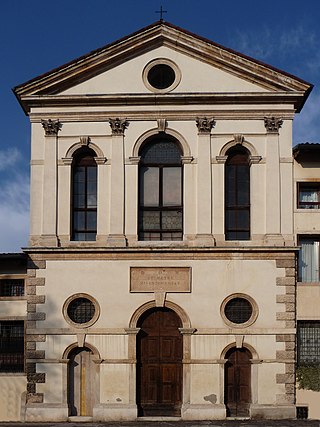
The Misericordia Hospital was one of the oldest hospitals in the city of Vicenza and, for several centuries, the main orphanage in the city. Of the buildings, located in the district of the same name in Borgo Pusterla, only the church of the Misericordia now remains, since 2010 officiated by the Serbian Orthodox parish of San Luca, while those used as an orphanage have been completely demolished or renovated for civilian use.
25. Chiesa di Santa Corona
Santa Corona is a Gothic-style, Roman Catholic church located in Vicenza, region of Veneto, Italy. The church contains the Valmarana chapel, whose design is attributed to the Renaissance architect Andrea Palladio. Palladio himself was initially buried in this church.
26. Loggia Valmarana
The Loggia Valmarana located inside the Salvi gardens, also called Valmarana Salvi gardens, was probably built in 1591 by a student of Andrea Palladio by the will of Gian Luigi Valmarana himself, who wanted this place become a meeting point between intellectuals and academics.
27. Oratorio delle Zitelle
The Oratory of the Zitelle is an oratory built in the mid-seventeenth century for the "Pious House of Santa Maria delle Vergini", also known as the "Hospice of the Zitelle" and located in Vicenza in Contrà Santa Caterina in the area of Borgo Berga.
28. Museo del Gioiello
The Vicenza Jewelry Museum is a civic museum of art and design based in Vicenza, Italy. Located in the Palladian Basilica, it is a museum of jewelry design that preserves the works of jewelry artists such as James Rivière and Giò Pomodoro.
29. Chiesa di Santo Stefano
The church of Santo Stefano is a religious building in Vicenza, Italy, built in the Baroque style between the end of the seventeenth and the first half of the eighteenth century on the site of one of the oldest chapels in the city.
30. Palazzo Porto
Palazzo Porto is a palace built by Italian Renaissance architect Andrea Palladio in Contrà Porti, Vicenza, Italy. It is one of two palaces in the city designed by Palladio for members of the Porto family. Commissioned by the noble Iseppo da Porto, just married, this building had a rather long designing stage and a longer and troublesome realization, partially unfinished.
31. Palazzo Trissino Trento
Palazzo Trissino al Duomo is a large building located in via Cesare Battisti 10 in Vicenza, commissioned by Pier Francesco Trissino to Vincenzo Scamozzi in 1577 and later enlarged by Giambattista Albanese in 1621-1622 for Achille Trissino, grandson of the founder. The façade has remained a fine example of Renaissance architecture, while much of the interior decoration has been lost. Subject to historical and artistic architectural constraints since 25 May 1960, it has been the headquarters of a bank since 1906.
32. Chiesa di Santa Croce in San Giacomo Martire - Carmini
The church of Santa Croce in San Giacomo Maggiore known as dei Carmini is a religious building in Vicenza, Italy, located in Piazza dei Carmini at the end of Corso Fogazzaro. The Carmelite convent was annexed to it, hence the nickname by which it is still known. Renovated in the sixties of the nineteenth century in neo-Gothic style, it is the parish seat.
Wikipedia: Chiesa di Santa Croce in San Giacomo Maggiore (IT)
33. Oratorio dei Boccalotti
The Boccalotti Oratory is an oratory, located in Vicenza in Piazzetta San Pietro, built at the beginning of the fifteenth century, at that time annexed to the hospital of Santa Maria and Saints Peter and Paul.
34. Palazzo Thiene Bonin Longare
Palazzo Thiene Bonin Longare is a patrician palace in Vicenza, northern Italy, designed by Italian Renaissance architect Andrea Palladio, probably in 1572, and built after Palladio's death by Vincenzo Scamozzi. It is one of the city palazzi of the Thiene family that Palladio worked upon, the other being Palazzo Thiene in the near contrà Porti.
35. Villa Ghislanzoni
Villa Chiericati Ghislanzoni del Barco Curti is a Venetian villa, located on the outskirts of the city of Vicenza in the locality of Bertesina, built in 1764 on a design by an unknown architect, perhaps by Antonio Gaidon from Bassano.
36. Chiesa di Santa Caterina in Porto
The church of Santa Caterina in Porto, also known as Santa Caterinella, is a religious building in Vicenza, located in Borgo Berga just beyond number 158, rebuilt in Renaissance style in 1677 on the site of a previous church of 1423.
37. Teatro Comunale
Teatro Comunale Città di Vicenza is a modern theatre structure consisting of a main hall, the “Sala Maggiore”, with 910 seats and a second one with 380 seats, and the so-called “Ridotto”. The structure was planned by the architect Gino Valle and inaugurated in December 2007. It is located in Vicenza, Italy, a city included in the World Heritage List UNESCO, not far away to Venice.
38. Chiesa dei Santi Bernardino e Chiara
The church of Saints Bernardino and Clare, commonly known as the church of Santa Chiara, is a religious building in Vicenza, Italy, located in Contrà Santa Chiara, built in Renaissance style at the end of the fifteenth century for the monastery of the same name of the Poor Clares. It is currently a dependency of the Palazzolo Institute of the Sisters of the Poor.
39. Chiesa di Santa Maria Nova
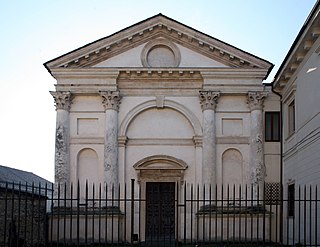
Santa Maria Nova is a Roman Catholic church in Vicenza attributed to 1578 designs by Italian Renaissance architect Andrea Palladio. It is the only complete church design in Vicenza assigned to Palladio, although he did design the Valmarana chapel in Santa Corona, a portal and the cupola of the Cathedral, and the portal of Santa Maria dei Servi.
40. Casa Cogollo
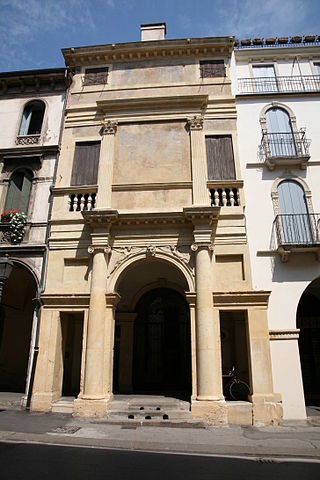
Casa Cogollo is a small palazzo in Vicenza built in 1559 and attributed to architect Andrea Palladio. Since 1994 it has formed part of the UNESCO World Heritage Site "City of Vicenza and the Palladian Villas of the Veneto".
41. Gallerie di palazzo Leoni Montanari
The Palazzo Leoni Montanari is a late Baroque palace located in Contra’ San Corona number 25 in central Vicenza in the Veneto region of Italy. It now houses exhibition rooms, meeting places, and art collections owned by the bank, Intesa Sanpaolo.
42. Chiesa di San Filippo Neri
San Filippo Neri, also called the Chiesa dei Filippini or San Marcello in San Filippo Neri, is a Neoclassical-style, Roman Catholic church located on Corso Palladio #35 in the city of Vicenza, region of Veneto, Italy.
Share
How likely are you to recommend us?
Disclaimer Please be aware of your surroundings and do not enter private property. We are not liable for any damages that occur during the tours.
